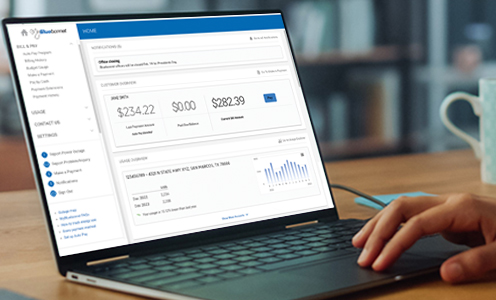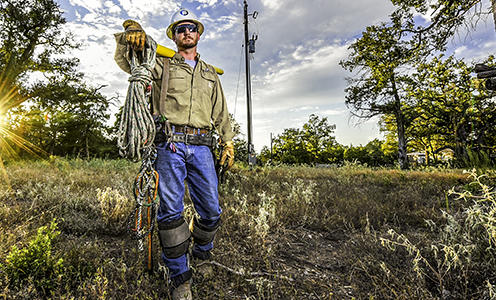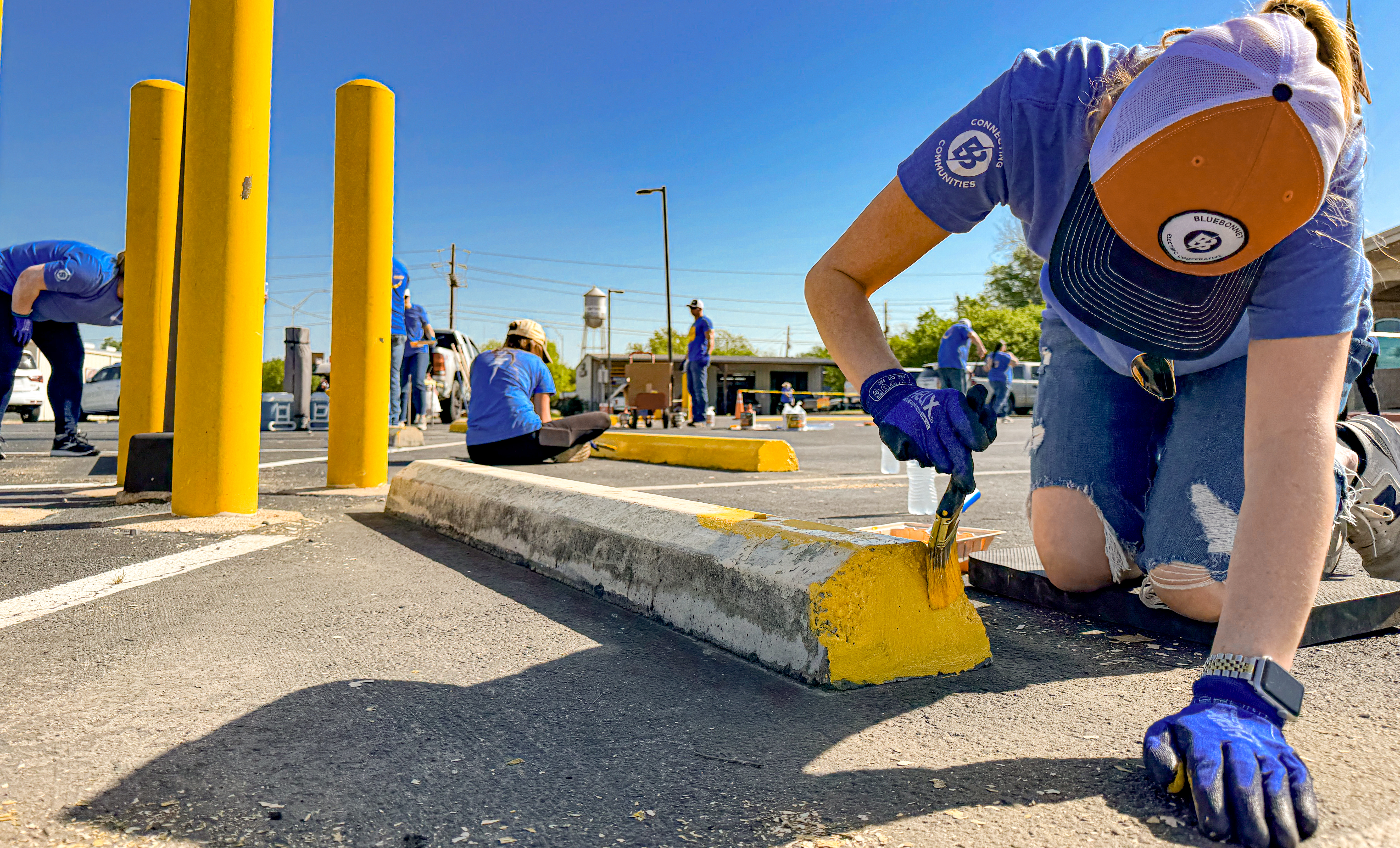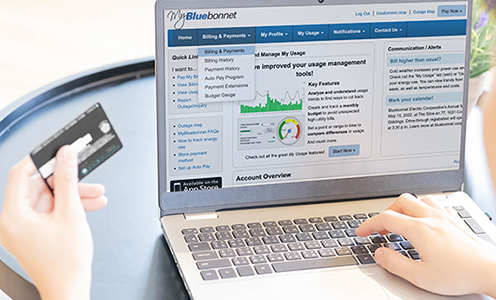The cooperative way
Recent news
Solar power, battery storage and EVs were the talk of the day
By Sidni Carruthers
The morning started off overcast and chilly, but that did not deter almost 100 Bluebonnet Electric Cooperative members from attending the co-op’s 2022 Energy Expo on Oct. 22. It was Bluebonnet’s seventh renewable energy event for members.
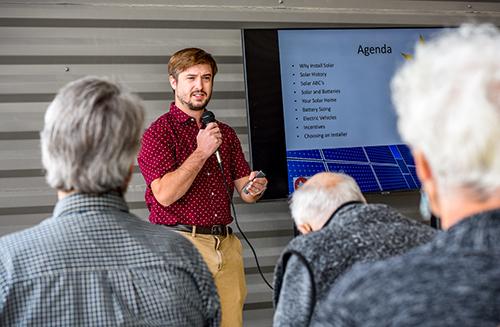
The Energy Expo, previously known as Solar Day, was at the cooperative’s service center in Maxwell, midway between Lockhart and San Marcos in Caldwell County. It was the first year Bluebonnet has offered the in-person event since 2019.
This year, in addition to receiving expert information, hearing a detailed presentation and getting answers to questions about solar energy systems, members learned about residential battery storage arrays and electric vehicles.
As it has in previous years, the Texas Solar Energy Society offered a Solar 101 presentation and an installer fair. One Bluebonnet member who has both a solar system and battery storage at his home answered questions about his experience.
Bluebonnet staff members talked to attendees and provided information about the increasingly popular topic of whole-house battery systems that can store power generated by home solar arrays. Also included in the day’s events was information about electric vehicles and tours of Bluebonnet’s Maxwell service center, which has 292 solar panels and two rainwater collection tanks that each hold 30,000 gallons of water.
Micah Jasuta, a member of the nonprofit Texas Solar Energy Society and its former board chairman, provided a presentation about how solar installations work, their costs, how effectively they reduce power bills and what questions to ask installers. He also spoke about common myths and misconceptions about solar-generated power, best practices when choosing an installer and the basics about battery storage.
After learning that the federal government will continue to offer — and increase — tax credits for renewable energy and battery storage systems, Bluebonnet members Bob and Nancy Arnold decided to make the drive from Lexington in Lee County to attend the event. “We want to do our due diligence,” Bob Arnold said. The couple has been looking into solar energy systems for several years.
Stephanie Morales, a Bluebonnet member from Dale in Caldwell County, came to the Energy Expo in search of the latest information. “I know solar has been around a while, but I know batteries have improved, so I want more information to make the most educated decision on whether to go solar or not,” she said.
The most interesting part of the event for Audrey Castro, a Bluebonnet member from Cedar Creek in Bastrop County, was Jasuta’s presentation. “He had a ton of information, some I knew, but some I didn’t know,” Castro said.
Bluebonnet has had a 32% increase in the number of solar energy installations on its grid since 2021, and the co-op estimates that pace will continue for several years.
To learn more about renewable energy, go to bluebonnet.coop/energy-solutions, or call member services at 800-842-7708. Get more information from the Texas Solar Energy Society's website, txses.org.
Commuting subsided during the pandemic, but many Bluebonnet-area drivers have returned to the weekday trek. Some of them never stopped.
Sharon Jayson l Photos by Laura Skelding
Rick Gaskamp is a Brenham native who loves his hometown so much that rather than move, he's spent the past 21 years as a weekday commuter to Houston. He's got 414,000 miles on his 2013 black pickup, which is just the latest in a series of trucks and vans he's driven to and from work most weekdays.
Every Monday through Friday, the self-employed carpenter hops in his Chevrolet Silverado 2500HD and drives some 80 miles to various job sites in the city, where he works on new and remodeled multimillion-dollar properties for a homebuilder. He earns more than he did when he worked closer to home. Each one-way trip takes an hour and 15 minutes, an endurance stretch Gaskamp knows well from his thousands of hours of experience.
HOW MANY COMMUTERS ARE IN AND AROUND THE BLUEBONNET AREA?
TIPS TO STAY CALM AND DRIVE ON
He leaves home at 5 a.m. and returns 12 hours later. "I know what time to leave to get there before the traffic is bad," he said, explaining that he can be at a job site by 6:15 a.m. if he leaves at 5 a.m.
"I've learned a lot of shortcuts," said Gaskamp, a Bluebonnet Electric Cooperative member. "When I get halfway to Houston, I listen to Houston traffic (radio reports). If there's a wreck on the way I normally go, there are multiple ways to go around it."
That is, unless he's already on the road where the collision occurred. "Sometimes you just got to wait," he said.
The commuting culture had a major shakeup during the COVID-19 pandemic shutdown and the rise of remote work. No one knows if it will return to pre-pandemic levels. Today, nearly 60% of U.S. workers have the opportunity to work from home at least one day a week, according to a 2022 report by McKinsey & Company, a global consulting firm. Of those workers, 35% can work from home five days a week, the report said.
That's all well and good for those who spend a lot of time at a desk and in virtual meetings, but many Bluebonnet Electric Cooperative members have jobs that require them to return to their workplaces. Plus, steady growth and development in the region -- and employers beckoning workers to come back -- means plenty of commuters are returning to Central Texas roads.
Before the pandemic, more than 80% of Texas workers drove to their jobs alone, according to the U.S. Department of Transportation. During the height of the pandemic, carpooling was discouraged to contain the virus spread.
Now, along with more workers returning to the office as well as hybrid work schedules, experts say the nature of rush hour has changed, with many doing errands at various hours rather than on the way to, or from, work. The price of gasoline, and the inevitable wear and tear on vehicles, also factors into today's commuting choices.
In 2019, the average one-way travel time to work was at an all-time high of 27.6 minutes, according to the U.S. Census. But experts say the 2020 Census commuting data released this year is skewed by the pandemic, making a pre-COVID comparison unreliable.
"We just don't know what (commuting) is going to look like a year or two or five from now," said David Schrank, a senior research scientist at the Texas A&M Transportation Institute in Bryan. "If you put your 2019 hat on, we had a pretty good idea about what a Monday, Tuesday or Wednesday looked like if you were one of those commuters. We spent decades getting to that point. All that got undone in a year or two (by COVID) and now it's going to take a few years for that to settle in and figure out what that's going to look like."
Legions of workers are redesigning their ways of working. Their transportation decisions will depend on employment opportunities, growth in their area, road construction or improvements, the availability of mass transit and carpooling, and, of course, remote-work options. Bluebonnet members across the cooperative's 3,800-square mile service area are making these decisions daily.
For Meredith Brown of Luling, the 45-minute drive to her job at Texas State University in San Marcos means she's on Texas 80 door-to-door -- unless there's a problem.
"The other day, there was a wildfire and they had 80 blocked off," she said. But because she grew up in the area, Brown knew how to use back roads to get to work.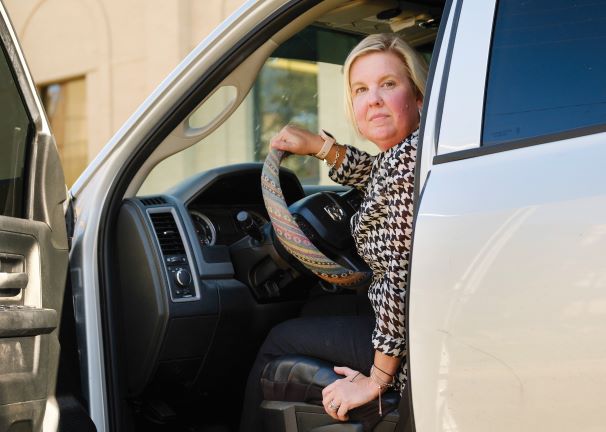
Brown has been assistant to the executive director of housing and residential life at Texas State since 2015, but she has commuted from Luling only for a few months. She and her family moved from family-owned property in another part of Caldwell County in mid-July. Her commute used to be just 20 minutes. Now, with just one lane in each direction on Texas 80 and three traffic lights, she can drive the majority of the 30 miles to the office with a 65 mph speed limit until Martindale, 7 miles east of San Marcos. There, the speed limit drops to 55 mph.
"Commuting doesn't bother me," Brown, a Bluebonnet member, said. "It's not bad for me -- it's not like I-10 or I-35 that have massive traffic. It's not super congested." She makes the drive in her sturdy 2018 silver Ram 1500 pickup.
Brown's youngest child attends preschool in Martindale, so they leave their house about 6:15 a.m. She drops off her son about 15 minutes later, then works on campus from 7:30 a.m. to 4:30 p.m. She picks up her son and they typically arrive home by 5:45 p.m. Independent transportation research consultant Alan Pisarski, of Falls Church, Virginia, has spent 35 years analyzing commuting. Workers whose jobs involve ideas and information -- a rapidly growing portion of the workforce -- can more readily work remotely, he said. Also, many urban dwellers moved to the suburbs during the height of the pandemic and are "much less interested in coming back," he said.
"It will be 2023 before I can say it's comparable to 2019," he said. Today, even the definition of a commute is unclear, Schrank, the A&M research scientist, said. "The question is 'Are you a commuter if you drive in one day a week?' Commuters used to be five-day-a-week travelers," he said.
Roads in parts of Bluebonnet's service area are congested now, in part, because of the jump in population over the past two years, said William Frey, a census and demographics expert at the Brookings Institution in Washington, D.C. In particular, he noted growth in Bastrop and Caldwell counties.
That is no surprise to Jason Giulietti. He's president of the Greater San Marcos Partnership, an economic development nonprofit that serves the City of San Marcos, as well as Hays and Caldwell counties, which he said are experiencing "exponential and record-setting growth."
Giulietti is a transplant, having moved to Texas from Connecticut in early 2019.
"I live in New Braunfels," he said. "When I look at my neighbors, every person on my street is from another state."
Besides residential development, fiscal 2021 set a record for his organization, completing 14 new development project deals on the heels of six the previous year. Six of the 14 projects are within the city of San Marcos. A 1.1 million-square-foot Amazon facility opened in November 2021, adding to already existing Amazon sites and cementing Amazon as the largest employer in the San Marcos region.
"What we measure that drives the jobs and residents here is they don't have to commute to an Austin or to a San Antonio for those jobs," Giulietti said. "The more we bring the jobs locally, the less they have to commute."
That's not the case for Laura Fohn, a Bluebonnet member who lives in The Woodlands neighborhood of Bastrop near Texas 21 and Texas 71. She commutes 26.4 miles each way to Dell Seton Medical Center at the University of Texas near downtown Austin.
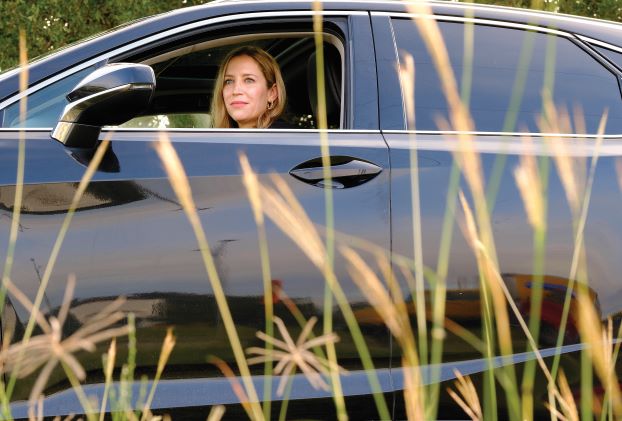
"If I leave before 7 a.m., I (miss) the rush at Del Valle. Once you cross over into Travis County, it gets kind of rough," she said. For her return home, she leaves work around 6 p.m.
Trouble spots on her route are mostly on Texas 71, at intersections where traffic lights and construction are still clogging the road. For her in-office hours as director of operations, Fohn said she leaves home as early as she can to spend more time with her family later. Although she said she works more than the 8-to-5 day, her aim
is not to waste time driving. Her morning commute takes about 45 minutes, and her drive home takes about an hour.
Traveling between 7-9 a.m. or 4-6 p.m. would take her an hour each way, she said. "It depends on the day," she said, "but I want to get in early and not leave time sitting on the road."
Although Fohn's commute is the same distance as when she lived in South Austin 10 years ago, Fohn said her travel time from Bastrop is quicker. During the pandemic lockdown, she still had to be at her office at the medical center every day.
"That's when I knew what (a quicker commute) could be. I could get home in 25 minutes."
Two years ago, Fohn traded in her Toyota Sequoia SUV for a smaller, four-door Lexus SUV. During her time in traffic, she "makes a lot of phone calls" and listens to podcasts and books by popular researcher and lecturer Brené Brown.
"I make it a positive since I know I can't control the situation," she said. "I don't let it get me down, although it does sometimes." Margaret Gómez, the Travis County Commissioner for Precinct 4, has been in Del Valle for many years, and watched its growth and development for decades.
"There is quite bit of commuting between Travis County and Bastrop County and Caldwell County," she said. "Most of it is families who have left Austin to get away from the high taxes and high cost of living."
She calls Del Valle "the last of the rural areas of Travis County." Gómez said major projects in Del Valle, including the Circuit of the Americas motor racing track and facilities -- as well as Tesla's global headquarters and Gigafactory Texas -- have fueled even more development.
Manor in eastern Travis County has become a more affordable option than Austin, said Scott Dunlop, Manor's development services director. The city "is still a better value," he said. "A majority of respondents (to a 2016 survey by the City of Manor, conducted by GrantWorks Inc.) said they moved here because of housing costs." More than half of respondents had lived in Manor five years or less, and almost 70% said they commuted to Austin for work. Just 14% reported working in Manor.
An online City of Manor survey also conducted by GrantWorks in summer 2021 for city planning into 2050 asked about the length of residents' one-way commutes. Almost 41% said it took 30 to 45 minutes to get to work; almost 28% said 15 to 30 minutes and 24% said more than 45 minutes. Just 7% said less than 15 minutes.
Such short commutes are but a dream for Gaskamp, the carpenter who drives to Houston five days a week. If he doesn't end his workday by 3:30 p.m. and get on the road within 10 minutes, he faces a two-hour minimum commute home.
Each weekday morning, he tunes into Brenham radio for news and music until he crosses the Brazos River, where he loses that station and switches to radio news with Houston's weather and traffic. He knows if he left his home at 6 a.m., his journey would take two hours rather than only 75 minutes when he leaves at 5 a.m.
It may sound like an extremely long commute to some folks, but Gaskamp's system is finely tuned.
"The alarm goes off at 4 and I hit snooze once or twice and get a cup of coffee and pack my lunch," Gaskamp said. "I'm so used to my routine."
Commuting in & around the Bluebonnet area
The U.S. Census Bureau's most recent data is a five-year estimate (2016-2020) of the number of workers commuting daily. The 2020 data skewed lower than normal because of the pandemic's impact on commuting. County totals include areas outside Bluebonnet's service area. Travel is mean time, rounded.*
Commuters: 13,916
Travel time: 28 minutes
Commuters: 37,595
Travel time: 35 minutes
Commuters: 7,334
Travel time: 28 minutes
Commuters: 18,916
Travel time: 34 minutes
Commuters: 10,785
Travel time: 24 minutes
Commuters: 112,192
Travel time: 31 minutes
Commuters: 7,911
Travel time: 30 minutes
78653 ZIP code, includes Manor area Commuters: 14,598
Travel Time: 30 minutes
78617 ZIP code, includes Del Valle area
Commuters: 13,577
Travel time: 32 minutes
78621 and 78747 ZIP codes, includes parts of Bluebonnet service area
Commuters: 22,402
Travel time: 32 minutes, 34 minutes
Commuters: 15,617
Travel time: 21 minutes
* Mean travel time is obtained by dividing the total number of minutes by the number of workers 16 and older who did not work at home. Most times are rounded.
Buckling up for a long drive to work? Just breathe.
By Denise Gamino
The grind of a daily commute to work can leave you frazzled and a bit breathless.
Knowing how to calmly breathe through the stress can be the best fix.
Slowing your breathing by making your exhalations twice as long as your inhalations, for example, can reduce commuting stress, according to health research.
"Slow breathing practices could transform the automobile commute from a depleting, mindless activity into a calming, mindful experience," according to a 2018 study by Stanford University researchers and others.
The study, "Just Breathe: In-Car Interventions for Guided Slow Breathing," used voice-guided prompts and vibrating seat and back cushions to remind drivers to achieve slow, rhythmic breathing. But drivers really don't need electronic prompts. Any driver at any time can work to slow down their breathing just by lengthening exhalations, such as inhaling to a count of 5, holding briefly, and then exhaling to a count of 10.
And, working to keep your breath slow and steady in traffic is a free exercise with big stress-management benefits.
Here are other ways to stay safe and alert during long commutes:
- Concentrate on watching the road and keeping your hands on the wheel. Never text or email while driving, even if you can use voice commands only. Use the time to stop working.
- Do isometric exercises. Contract your abdominal muscles by pulling the belly button inward toward your spine and hold for 10 to 60 seconds. Or contract and release thigh or calf muscles -- don't forget to breathe.
- Change the angle or position of the driver's seat regularly so your spine isn't in the same position every time you drive.
- Expect unexpected road delays and eliminate worries about being late to work by leaving 15 minutes early.
- Try the occasional different route to or from work, if an option is available, to relieve boredom. Knowing the back roads and alternate routes can also be handy in case of gridlock.
- Listen to podcasts, and try ones about topics you know little about. Change up what you listen to: Try practicing a foreign language or exploring audiobooks.
- Bring your own coffee or water, protein bars and fruit for emergencies, and have backup power supplies for your phone or flashlight.
- Use a lumbar or seat cushion that provides support and helps absorb road vibrations.
Sources: Cedars-Sinai Medical Center, Healthline, National Institutes of Health, Robert Half human resources company, Self magazine
Are you one of these kinds of long-haul commuters?
The U.S. Census Bureau tracks commuting on roads across America. It has designations for three types of long-distance commuters. With the decrease in long-distance work drives starting in 2020 due to the COVID-19 pandemic, it's likely the numbers of these long-haul commuters has dropped. Still, Central Texas drivers may find themselves in one of these categories of far-distance trekking to work.
EXTREME COMMUTER
This is someone who travels 90 minutes or longer to work, one way (that's 3 hours a day of driving!)
LONG-DISTANCE COMMUTER
A worker who travels 50 miles or farther to work, one way, for a total of 100 miles driven every workday.
MEGA-COMMUTER
Let's hope you're not in this category. This is a commuter who drives for 90 minutes or longer and 50 miles or farther to work, each way, each workday.
Going solar or already gone? The next hot sellers in Central Texas homes are battery storage systems, which can conserve that power for later use.
By Alyssa Dussetschleger
It's been a long time coming, but home battery storage of solar-generated power has started showing up on the walls and garages of homes in the Bluebonnet Electric Cooperative service area.
Although battery technology has improved and prices have gone down in recent years, adding battery storage to your solar system is still pricey. The average cost of a 13-kilowatt hour (kWh) home battery plus its installation in Texas ranges from about $13,700 to $18,530, according to EnergySage, an online database of solar and battery installers that partners with the U.S Department of Energy. Those prices will probably drop by thousands of dollars in the next eight years, according to forecasts from the National Renewable Energy Laboratory.
TAKE SMART STEPS TO CHARGE EV AT HOME »
BLUEBONNET AMONG FIRST TO TEST NEW TESLA DEVICE »
TOP FIVE OPTIONS ON THE HOME BATTERY MARKET »
LOOKING FOR A FORD LIGHTNING? »
Increasingly, homeowners in the Bluebonnet Electric Cooperative area, as well as in Texas and across the nation, are taking the leap into renewable energy. Storing excess energy generated by their solar arrays could save homeowners money and provide a backup source of power during an electric outage.
Solar power is one of the fastest-growing sources of electricity in the United States and has the potential to provide as much as 40% of the nation’s power needs by 2035, according to a 2021 study by the U.S. Department of Energy.
U.S. households with solar systems produced enough electricity in 2021 to power 23 million average homes for one hour, a whopping 126.1 gigawatts of power (a gigawatt is 1 billion watts). Texas has more than 160,000 residential and small commercial solar systems, second in the nation behind California, according to a spring 2022 study by the Solar Energy Industries Association, Wood Mackenzie Power & Renewables and The Solar Foundation.
There were 2,558 home solar installations on the Bluebonnet system as of September 2022. At the end of August, Bluebonnet members (including large commercial members) with solar installations had the capacity to generate 26.58 megawatts of power (a megawatt is 1 million watts). That’s enough to power 5,316 homes during periods of peak electricity demand.
In 2021, Bluebonnet residential and commercial members with renewable power systems sent 8,940 megawatt hours of unconsumed power back to the grid. There are approximately 67 new solar systems, primarily residential, added to Bluebonnet’s grid every month.
Those are all great resources when the sun is shining, and power production peaks at midday. But households use the most electricity from 3 to 8 p.m. in the summer, when solar power production is waning. No sun means no electricity from a solar system.
Storing that power has been an elusive next step.
Residential battery storage systems connect to solar (or less-commonly, wind energy systems) to capture electricity that isn’t used while it is being produced. The electricity stored in residential batteries can be used in the evening, during a power outage or when cloudy skies or still air prevails.
Because battery storage system installations are not regulated by the state or federal government, official statistics are not available. A study by S&P Global Market Intelligence estimates an eight-fold increase in home battery installations since 2020. Bloomberg New Energy Finance, which conducts research on how industries can adapt to energy transitions, forecasted in 2019 that by 2024, battery installations will have increased 122% globally.
In addition, the new federal Inflation Reduction Act, enacted in August of this year, increases federal tax credits for installation of solar and other renewable energy systems — including battery storage — beginning in 2023. The credit will equal 30% of the costs of eligible home improvements made during the year. Learn more about the Inflation Reduction Act at bit.ly/3QfvqQ1.
“We are seeing a 24% (sales) rate for batteries (paired) with solar so far this year, up from 18% last year,” said Sherren Harter, chief marketing officer at Freedom Solar. By late August, the Austin-based company had installed 68 combined solar and battery systems for Bluebonnet
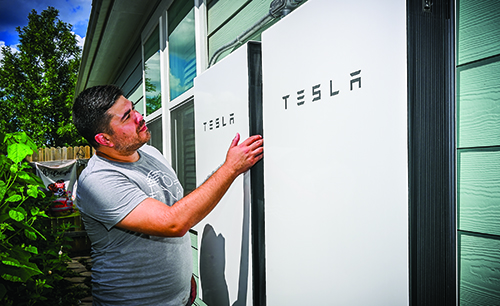
Amancio Gutierrez, a Bluebonnet member in southern Travis County, installed a full-home battery backup and rooftop solar system in 2020. His two Tesla Powerwalls can provide up to 18 hours of backup power for his home.
Another Bluebonnet member, Aaron Contreras of eastern Travis County, added solar battery storage in 2020. “The icing on the cake for battery storage was being able to keep the lights on” during the winter storm of 2021, he said. “At the time I added battery storage I didn’t consider that at all. I had been a Bluebonnet member for 11 years and only lost power one time for more than five minutes. But during the winter storm, I was able to keep the lights, heater and a few outlets on without interruption the entire time.”
Want to learn more? Here are a few questions and answers about battery storage systems.
How does battery storage work?
Electricity generated by solar or wind systems is direct current, or DC, which cannot be used in homes. That electricity flows through an inverter, turning it into alternating current, or AC, which can then power your home. Any excess electricity flows back through the system to the battery, where that power can be stored and used when needed. If the battery doesn’t have enough power stored to meet your electricity demand, your home will use electricity from Bluebonnet’s system.
Without a battery, what happens to power my system generates that I don’t use?
Excess electricity you produce is returned to the grid and purchased from you by Bluebonnet. If you add battery storage to your system, that excess power first charges the battery before being returned to the grid.
What is in these batteries?
Typical home battery storage systems use lithium-ion or lead-acid batteries. Lithium-ion batteries cost more, but have a longer life expectancy and come with more all-in-one, wall-mountable packages. Lead-acid batteries are less common and carry some safety risks.
Are there different battery sizes? How do I know the size I need?
The average electric battery storage system for homes stores about 10 kilowatt-hours, or kWh, enough to run a clothes dryer for 2 to 5 hours. For an average home with solar panels in Central Texas, under sunny conditions and using no electricity, a solar system could recharge, for example, a 9.6 kWh battery from the LG Chem company in two hours.
Batteries range in size, from about the dimensions of a large flat-screen TV to a clothes dresser. The most compact, LG’s Energy Solution home battery, is 36 inches tall, 29 inches wide and 8 inches deep. The Sonnen Eco 15, one of the largest home batteries, is 84 inches tall, 26 inches wide and 19 inches deep.
The capacity size of the battery (measured in kWh) or number of batteries you need depends on how much electricity you want to store and how you plan to use it. Stored electricity can back up just part of your home, or it can provide full-home backup. An additional breaker box, with only breakers to the appliances that will be backed up by the battery storage, will need to be installed for a partial backup system. The time it takes to charge one or more batteries varies based on the size of your solar system and how much electricity you use from it while it is generating power.
The most common items that residents back up are refrigerators, freezers, TVs and a few outlets, said Ray Schafer, a technical sales associate at Lighthouse Solar. Large appliances, such as HVAC systems and clothes dryers, often use too much power for a single battery.
The more devices and appliances using power from your battery storage system, the less time you’ll get power from it. A whole-home battery backup will exhaust its power storage faster than a partial one.
Gutierrez, the Bluebonnet member in southern Travis County, became interested in additional solar and battery storage at the start of the COVID-19 pandemic, when he was spending more time at home. He decided to get a full-home battery storage backup “in case of emergencies.”
A professional installer can help you determine the size and number of batteries needed. Ideally the company will spend time helping you make the best decision for your needs with your renewable energy system. Battery installation education can be tricky, said Chris Lermann, owner of Affordable Solar, Roof & Air, a Tomball-based solar and battery storage installation company. “There are so many different loads you can utilize batteries for, so education is key,” he said.
You can also gauge the battery size you might need by using online calculators at pvwatts.nrel.gov.
Is there a wait for batteries?
Since 2020, supply chain delays have impacted residential battery availability. Batteries from the company Enphase, for example, can take about 120 days to be delivered once a contract is signed. A Tesla Powerwall for solar energy can take from two months to a year to arrive, depending on the installer, location and available stock.
Where can I get good advice about buying a battery storage system?
Most solar installers also install battery storage systems. The brands of batteries installers sell and install will vary by their training and certification for the battery brand.
For example, Sonnen, a popular battery manufacturer, requires licensed electricians to take and pass an online exam before selling or installing its batteries. Make sure your installer is registered with the Texas Department of Licensing and Regulation at tdlr.texas.gov.
Micah Jasuta, a Texas Solar Energy Society member and past board chair, recommends that if you know someone who has had a battery installed, ask them about their experience. There are online tools to help, too. Energysage.com is a database to help consumers learn average system costs by battery size and model, and to find storage system installers in your area. Each company in that database has reviews from other buyers, along with services it provides, industry certifications, manufacturer partnerships and associated companies. The Texas Solar Energy Society also recommends reviewing battery storage installation companies with the Better Business Bureau or on online review sources.
Jasuta advises getting at least three bids from licensed battery storage installers. “When people tell you something is free, be skeptical,” he said.
How much will it cost?
The average cost to purchase and install a residential solar system with battery storage can range from a little more than $19,840 to about $57,040, according to EnergySage. Prices vary greatly based on system sizes, quality and type of equipment installed. The average electric battery storage system in Texas costs $1,232 per kWh of storage. A 10 kWh system, which could power a typical home for 8 hours a day, costs about $12,400 in Texas.
The new federal Inflation Reduction Act provides a 30% tax credit for the cost of installing solar (including battery storage), wind and other renewable home systems. The credit is available from 2022 through 2032, and then will decrease to 26% in 2033 and 22% in 2034. The credit will then expire.
The tax credit can reduce the cost of a typical home energy-storage system by thousands of dollars, and the new law also offers tax credits and rebates for a variety of energy-efficient purchases, including electric vehicles and home improvements, according to a Kiplinger report.
Where are the batteries and other pieces of equipment placed?
Energy storage systems can only be installed in certain areas of your home, according to national fire protection regulations. Those areas include attached or detached garages, exterior walls or outdoors at least 3 feet from doors, windows, utility closets or storage/utility spaces.
The systems are typically connected to the electric grid through your Bluebonnet meter and your home’s electric panel. Licensed, professional electricians and battery storage installers can recommend the best location for your system, based on your wiring needs, but most batteries can be placed either in your home’s garage or on an exterior wall.
Some cities, including Austin, have ordinances prohibiting batteries from being installed inside your home. The city allows batteries in garages as long as there is a firewall between the garage and house, and there is a heat sensor. Many smoke detectors have heat-sensors.
Bluebonnet member Contreras purchased a Tesla Powerwall in July 2020. He placed it inside his garage, although his solar system inverter and wiring were on an exterior wall.
After a solar and battery storage installation is complete, a Bluebonnet service technician must ensure the installation meets safety requirements. Then a new meter will be installed to register how much solar power is returned to Bluebonnet’s power lines. You'll sign an interconnection agreement, and then the systems can be turned on.
Will battery storage help me save on my electric bill?
Yes, if you use stored power when renewable energy is not being produced. For a typical 10 kWh battery, if you used 100% of the stored energy when your solar system is not producing power, that would save about $35 a month. But, if you used only 70% of your stored energy in a home that uses the average 1,000 kWh of electricity a month, you would save about $24 a month.
It will take much longer for your savings to cover the cost of your investment when compared to a solar-only system. The “break even” period for solar and battery storage systems is based on your out-of-pocket costs, and tax incentives and credits, along with savings on your electric bill. In 2020, the average payback period for a solar-power system was about 12 years, according to data from EnergySage. The online calculator at energysage.com/solar/calculator-results can estimate your savings and payback period based on an average installation cost in your area and financing options. Battery storage systems often have a longer payback period than solar panel systems, although the benefits of backup power may outweigh the financial impact.
Payback time on a battery system has many variables, and can range from 5 to 14 years, according to a 2021 EnergySage study.
